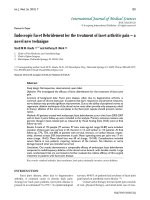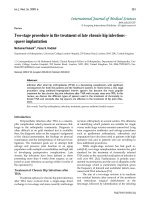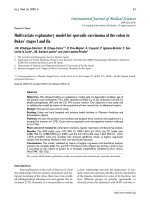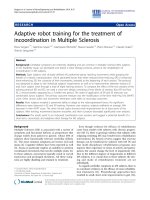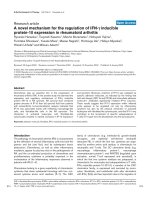Báo cáo y học: "Endoscopic thoracic laminoforaminoplasty for the treatment of thoracic radiculopathy: report of 12 case"
Bạn đang xem bản rút gọn của tài liệu. Xem và tải ngay bản đầy đủ của tài liệu tại đây (146.68 KB, 3 trang )
Int. J. Med. Sci. 2009, 6
224
I
I
n
n
t
t
e
e
r
r
n
n
a
a
t
t
i
i
o
o
n
n
a
a
l
l
J
J
o
o
u
u
r
r
n
n
a
a
l
l
o
o
f
f
M
M
e
e
d
d
i
i
c
c
a
a
l
l
S
S
c
c
i
i
e
e
n
n
c
c
e
e
s
s
2009; 6(4):224-226
© Ivyspring International Publisher. All rights reserved
Research Paper
Endoscopic thoracic laminoforaminoplasty for the treatment of thoracic
radiculopathy: report of 12 cases
Scott M.W. Haufe
1,2
, Ryan A. Baker
3
and Morgan L. Pyne
3
1. Chief of Pain Medicine and Anesthesiology
2. MicroSpine and Healthmark Regional Medical Center, Florida, USA
3. University of South Florida, Florida, USA
Correspondence to: Scott M.W. Haufe, M.D., 101 MicroSpine Way, DeFuniak Springs, FL 32435. Phone: 888-642-7677; Fax:
850-892-4212; Email:
Received: 2009.06.03; Accepted: 2009.08.10; Published: 2009.08.12
Abstract
Background: Spinal stenosis of the thoracic spine is less common than that of the cervical
and lumbar regions. Due to the close proximity to thoracic and abdominal organs, surgical
operations can be difficult and carry a greater risk of complications. The most efficacious
intervention for thoracic stenosis, whether central or foraminal, refractory to conservative
management is uncertain. We aimed to evaluate the efficacy of endoscopic laminoforamino-
plasty (ELFP) in the treatment of thoracic radiculopathy.
Methods: Twelve patients with radicular pain involving the lower thoracic levels (at or be-
low T6) were treated with ELFP.
Results: Seven of twelve patients showed marked improvement in pain scores. Average
follow-up scores were 2.9 and 12.08 on the Visual Analog Scale (VAS) and Oswestry Dis-
ability Index, respectively. The significance was 0.005 between the pre and post surgical data.
One patient with moderate symptoms, two with severe symptoms, and two with crippling
symptoms did not report significant improvement on VAS or Oswestry. No complications
were encountered.
Conclusions: Endoscopic laminoforaminoplasty offers an alternative to fusion or conven-
tional laminotomy with similar success rates. Patients additionally benefit from a decrease
risk of complications, short hospital stay, and faster recovery.
Key words: thoracic, radiculopathy, laminoforaminoplasty, minimally invasive, endoscopic, spi-
nal stenosis
Introduction
Radicular back pain is an important public
health issue that can result in long term disability and
poor quality of life. Conservative therapy is the initial
treatment of choice, but fails to provide relief in a
substantial number of patients. Central and foraminal
stenosis with entrapment of descending and/or exit-
ing nerve roots is a common cause of radicular pain,
with an estimated incidence of 8 to 11% [1] [2] [3].
Spinal stenosis of the thoracic vertebrae is less
common than that of the cervical and lumbar regions.
In our experience, patients tend to be older and are
more commonly male. Due to the close proximity to
thoracic and abdominal organs, open surgical opera-
tions can be difficult and carry a greater risk of com-
plications due to the requirement of a transthoracic
approach. The most efficacious intervention for tho-
racic stenosis refractory to conservative management
is uncertain at this time.
Here we report on our experience with 12 pa-
tients diagnosed with thoracic radiculopathy due to
Int. J. Med. Sci. 2009, 6
225
central or foraminal stenosis treated with endoscopic
laminoforaminoplasty via a small incision, of less than
one inch.
Materials and Methods
Twelve patients were treated with endoscopic
laminoforaminoplasty (ELFP) of the thoracic spine for
radicular pain. All patients were diagnosed with
radicular pain involving the lower thoracic levels (at
or below T6). No upper thoracic stenosis patients
were encountered at our clinic. Prior to surgery, all
patients were treated with conservative therapy, in-
cluding physical therapy and epidural steroid injec-
tions, which failed to provide adequate relief.
The surgery commenced as follows: The patient
was properly draped and prepped. Intravenous (IV)
antibiotics were administered perioperatively; cefa-
zolin was used unless there was an allergy, in which
case ciprofloxacin was substituted. The patient was
sedated but alert. Remifentanil and midazolam were
the most commonly used sedating agents. Utilizing
fluoroscopy, the entry site was then determined and a
3/4-inch incision was made at a 30-degree angle to the
vertebrae. Through this incision, a guide wire was
inserted down to the lamina of the stenotic vertebra.
Over this guide wire a bullet system was inserted to
dilate the tissues to a final diameter of 14.5mm. A
5mm laparoscopy scope, with 3.2X magnification, was
used to visualize the procedure. A 6mm drill bit was
used to create a laminotomy opening. Pituitaries and
kerrisons were then used to remove bulk tissues and
bone to open up the spinal canal. A standard burr
with a 6mm bit was used to remove bone and smooth
the bony edges of the opening. A holmium laser and
electrocautery was used for hemocoaugulation and to
remove soft issues. Once the region was decom-
pressed, the surgery was completed.
Outcome measures were percent change from
baseline in Oswestry Disability Index (Oswestry)
and Visual Analog Scale (VAS) pain scores. Scores
were assessed at baseline and again at follow-up.
Results
The author acknowledges that there are no con-
flicts of interest or financial benefits with the results of
the study. All twelve patients (10 males, 2 females)
completed the surgery without complication. Average
age was 60.2 years (range: 49-73). At baseline, most
patients reported moderate to disabling pain, with
average scores of 6.7 and 24.75 on the VAS and Os-
westry, respectively and the Individual patient data is
presented in Table 1. Utilizing the Student’s t-Test, the
data was separated into pre and post surgical scores.
Even though the sample size is small, the improve-
ment is significant with a p value of 0.005.
With all patients, follow-up was greater than 24
months postoperatively. Seven of twelve patients
showed marked improvement in pain scores. Average
follow-up scores were 2.9 and 12.08 on the VAS and
Oswestry, respectively. One patient with moderate
symptoms, two with severe symptoms, and two with
crippling symptoms did not report significant im-
provement on VAS or Oswestry. Of the twelve pa-
tients, 8 had foraminal stenosis and 4 had central is-
sues per both MRI and surgical report.
Table 1. Baseline patient characteristics and postoperative outcome
Sex Age Baseline VAS Baseline Oswestry* F/U VAS F/U Oswestry*
M 60 7 14 (28% Moderate) 1 2 (4% Minimal)
F 73 9 27 (54% Severe) 0 0 (0% Minimal)
M 56 7 19 (38% Moderate) 0 0 (0% Minimal)
M 46 7 19 (48% Moderate) 7 19 (48% Moderate)
M 57 7 21 (50% Moderate) 0 0 (0% Minimal)
M 70 3 27 (54% severe) 5 28 (56% severe)
F 73 8 33 (66% crippling) 0 4 (8% minimal)
M 69 7 21 (42% severe) 5 14 (28% moderate)
M 56 8 40 (80% crippling) 7 40 (80% crippling)
M 60 6 31 (69% crippling) 1 4 (8% minimal)
M 53 3 11 (22% moderate) 1 0 (0% minimal)
M 49 8 34 (68% crippling) 8 34 (68% crippling)
Int. J. Med. Sci. 2009, 6
226
Conclusions
Thoracic radiculopathy is rare, as evidenced by
the paucity of literature regarding the appropriate
management of these patients. In our experience, pa-
tients with thoracic central and foraminal stenosis are
more likely to be male, and tend to be of older age
than patients with cervical or lumbar disease. Also,
the stenosis tends to be foraminal and not central
since 66% of patients had foraminal stenosis. The
lower thoracic spine appears to be most commonly
affected. The correct surgical management of these
patients is based largely on data regarding lumbar
and cervical radiculopathy. However, in the thoracic
vertebrae proximity to both thoracic and abdominal
internal organs as well as prominent vascular and
neural structures increases the risk of adverse events
with invasive approaches.
Open surgical correction is the current standard
of care for foraminal stenosis of cervical and lumbar
vertebrae. Open surgery requires a longer operative
time, hospital stay, and postoperative recovery period
and carries significant risks. The anterior approach
requires a transthoracic approach with close prox-
imity to the major abdominal and thoracic organs and
neurovasculature [4], and posterior approaches re-
quire subperiosteal of the paraspinal muscles, which
can result in increased pain and spasms [5]. As with
any deeply invasive procedure, blood loss, infection,
prolonged hospital stay, and postoperative pain are
potential complications.
In contrast, interventions that are less invasive,
such as endoscopic laminoforaminoplasty, should
decrease the risk of major adverse events, allow for
same day hospital discharge, and decrease the need
for postoperative analgesia and immobility [5] [6].
In the current study, no adverse events occurred and
all patients were discharged the day of surgery. Ad-
ditionally, there was no need for thoracotomy, unlike
other surgical approaches. At the same time, reports
in the literature suggest similar patient outcomes to
conventional open approaches [7] [4] [8] [9]. In
this study, 7 of 12 patients (58.3%) experienced no-
ticeable improvement as evidence by decreased VAS
and Oswestry scores at postoperative follow-up, re-
sults consistent with published data.
Endoscopic laminoforaminoplasty offers an al-
ternative to fusion or conventional laminotomy with
similar success rates. Patients additionally benefit
from a decrease risk of complications, short hospital
stay, and faster recovery. This approach should be
considered in patients with simple thoracic radiculo-
pathy due to central or foraminal stenosis who fail to
benefit from conservative management. Finally, we
do recommend that a larger study would be beneficial
in confirming our data due to our small study group.
Conflict of Interest
The authors have declared that no conflict of in-
terest exists.
References
1. Kunogi J, Hasue M. Diagnosis and operative treatment of in-
traforaminal and extraforaminal nerve root compression. Spine.
1991; 16: 1312-1320.
2. Porter RW, Hibbert C, Evans C. The natural history of root
entrapment syndrome. Spine. 1984; 9: 418-421.
3. Vanderlinden RG. Subarticular entrapment of the dorsal root
ganglion as a cause of sciatic pain. Spine. 1984; 9: 19-22.
4. Gala VC, O'Toole JE, Voyadzis JM, et al. Posterior minimally
invasive approaches for the cervical spine. Orthop Clin North
Am. 2007; 38: 339-49.
5. Fessler RG, Khoo LT. Minimally invasive cervical microendo-
scopic foraminotomy: an initial clinical experience. Neurosur-
gery. 2002; 51: S37-S45.
6. Adamson TE. Microendoscopic posterior cervical lamino-
foraminotomy for unilateral radiculopathy: results of a new
technique in 100 cases. J Neurosurg. 2001; 95: 51-57.
7. Khoo LT, Fessler RG. Microendoscopic decompressive lami-
notomy for the treatment of lumbar stenosis. Neurosurgery.
2002; 51: S146-S154.
8. Perez-Cruet MJ, Kim BS, Sandhu F, et al. Thoracic microendo-
scopic discectomy. J Neurosurg Spine. 2004; 1: 58-63.
9. Yabuki S, Kikuchi S. Endoscopic partial laminectomy for cer-
vical myelopathy. J Neurosurg Spine. 2005; 2: 170-174.
